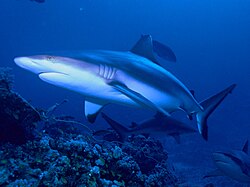| Genus Carcharhinus Blainville 1816 - 36 extant species |
| Common name | Scientific name | Geographic range | Conservation status
IUCN Red List | Length | Image |
|---|
| Blacknose shark | Carcharhinus acronotus
(Poey, 1860) |  | Endangered | 1.3 m (4.3 ft) |  |
| Silvertip shark | Carcharhinus albimarginatus
(Rüppell, 1837) |  | Vulnerable | 2–2.5 m (6.6–8.2 ft)
maximum 3 m (9.8 ft) |  |
| Bignose shark | Carcharhinus altimus
(S. Springer, 1950) |  | Near threatened | 2.7–2.8 m (8.9–9.2 ft)
possibly 3 m (9.8 ft) |  |
| Graceful shark | Carcharhinus amblyrhynchoides
(Whitley, 1934) |  | Vulnerable | 1.7 m (5.6 ft) |  |
| Grey reef shark | Carcharhinus amblyrhynchos
(Bleeker, 1856) |  | Endangered | Mostly less than 1.9 m (6.2 ft)
maximum 2.6 m (8.5 ft) |  |
| Pigeye shark | Carcharhinus amboinensis
(J. P. Müller & Henle, 1839) |  | Vulnerable | 1.9–2.5 m (6.2–8.2 ft)
max. 2.8 m (9.2 ft) |  |
| Borneo shark | Carcharhinus borneensis
(Bleeker, 1858) |  | Critically endangered | 0.7 m (2.3 ft) | |
| Copper shark | Carcharhinus brachyurus
(Günther, 1870) |  | Vulnerable | 3.3 m (11 ft) |  |
| Spinner shark | Carcharhinus brevipinna
(J. P. Müller & Henle, 1839) |  | Vulnerable | 2 m (6.6 ft)
maximum 3 m (9.8 ft) |  |
| Nervous shark | Carcharhinus cautus
(Whitley, 1945) |  | Least concern | 1.0–1.3 m (3.3–4.3 ft)
possibly 1.5 m (4.9 ft) |  |
| Pacific smalltail shark | Carcharhinus cerdale
C. H. Gilbert, 1898 |  | Critically endangered | 1.4 m (4.6 ft) |  |
| Australian blackspot shark | Carcharhinus coatesi
(Whitley, 1939) | | Least concern | 0.8 m (2.6 ft) |  |
| Whitecheek shark | Carcharhinus dussumieri
(J. P. Müller & Henle, 1839) |  | Endangered | 1 m (3.3 ft) |  |
| Silky shark | Carcharhinus falciformis
(J. P. Müller & Henle, 1839) |  | Vulnerable | 2.5 m (8.2 ft)
maximum 3.3 m (11 ft) |  |
| Creek whaler | Carcharhinus fitzroyensis
(Whitley, 1943) |  | Least concern | 1.0–1.3 m (3.3–4.3 ft)
possibly 1.5 m (4.9 ft) |  |
| Galapagos shark | Carcharhinus galapagensis
(Snodgrass & Heller, 1905) |  | Least concern | 3 m (9.8 ft)
maximum 3.3 m (11 ft) |  |
| Pondicherry shark | Carcharhinus hemiodon
(J. P. Müller & Henle, 1839) |  | Critically endangered | 1 m (3.3 ft) |  |
| Human's whaler shark | Carcharhinus humani
W. T. White & Weigmann, 2014 | | Data deficient | 0.8 m (2.6 ft) | |
| Finetooth shark | Carcharhinus isodon
(J. P. Müller & Henle, 1839) |  | Near threatened | 1.6–1.7 m (5.2–5.6 ft)
maximum 1.9 m (6.2 ft) |  |
| Smoothtooth blacktip shark | Carcharhinus leiodon
Garrick, 1985 |  | Endangered | 1.2 m (3.9 ft) |  |
| Bull shark | Carcharhinus leucas
(J. P. Müller & Henle, 1839) |  | Vulnerable | 2.3–2.4 m (7.5–7.9 ft)
maximum 3.6–4.0 m (11.8–13.1 ft) |  |
| Blacktip shark | Carcharhinus limbatus
(J. P. Müller & Henle, 1839) |  | Vulnerable | 1.5 m (4.9 ft)
maximum 2.6 m (8.5 ft) |  |
| Oceanic whitetip shark | Carcharhinus longimanus
(Poey, 1861) |  | Critically endangered | 3 m (9.8 ft) |  |
| Hardnose shark | Carcharhinus macloti
(J. P. Müller & Henle, 1839) |  | Near threatened | 1.1 m (3.6 ft) |  |
| Blacktip reef shark | TCarcharhinus melanopterus
(Quoy & Gaimard, 1824) |  | Vulnerable | 1.6 m (5.2 ft)
maximum 1.8 m (5.9 ft) |  |
| Dusky shark | Carcharhinus obscurus
(Lesueur, 1818) |  | Endangered | 3.2 m (10 ft)
maximum 4.0 m (13.1 ft) |  |
| Lost shark [7] | Carcharhinusobsoletus
White, Kyne, & Harris, 2019 | | Critically endangered (possibly extinct) | 0.37–0.43 m (15–17 in)
(juvenile length only) | |
| Daggernose shark | Carcharhinus oxyrhynchus (J. P. Müller & Henle, 1839) |  | Critically endangered | 1.5 m (4.9 ft) |  |
| Caribbean reef shark | Carcharhinus perezi
(Poey, 1876) |  | Endangered | 2–2.5 m (6.6–8.2 ft)
maximum 3 m (9.8 ft) |  |
| Sandbar shark | Carcharhinus plumbeus
(Nardo, 1827) |  | Endangered | 2–2.5 m (6.6–8.2 ft) |  |
| Smalltail shark | Carcharhinus porosus
(Ranzani, 1839) |  | Critically endangered | 0.9–1.1 m (3.0–3.6 ft)
maximum 1.5 m (4.9 ft) |  |
| Blackspot shark | Carcharhinus sealei
(Pietschmann, 1913) |  | Vulnerable | 1 m (3.3 ft) |  |
| Night shark | Carcharhinus signatus
(Poey, 1868) |  | Endangered | 2 m (6.6 ft)
maximum 2.8 m (9.2 ft) |  |
| Spot-tail shark | Carcharhinus sorrah
(J. P. Müller & Henle, 1839) |  | Near threatened | 1.6 m (5.2 ft) |  |
| Australian blacktip shark | Carcharhinus tilstoni
(Whitley, 1950) |  | Least concern | 1.5–1.8 m (4.9–5.9 ft)
maximum 2 m (6.6 ft) |  |
| Indonesian whaler shark | Carcharhinus tjutjot
(Bleeker, 1852) | | Vulnerable | 0.9 m (3.0 ft) |  |
|



















































